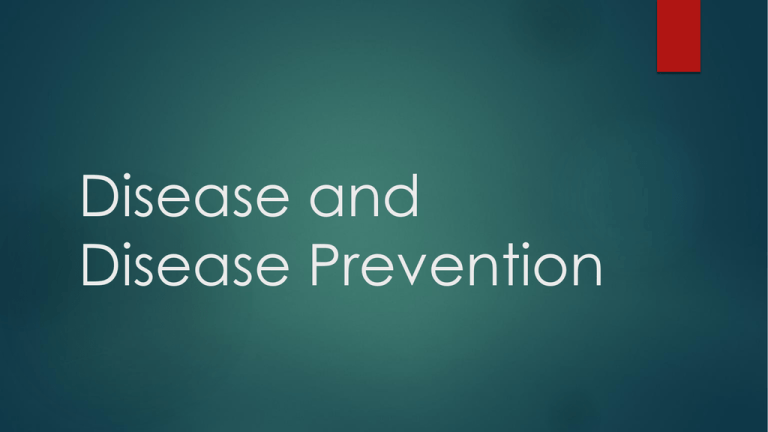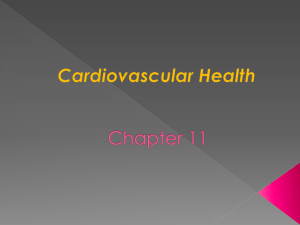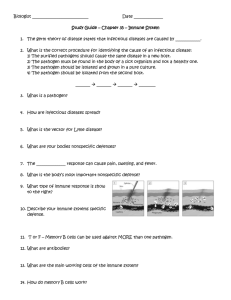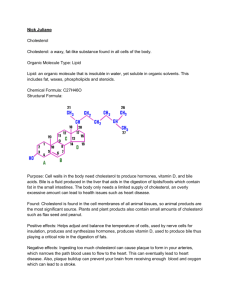5. Disease and Disease Prevention
advertisement

Disease and Disease Prevention Essential Questions How has the causes of death changed over the past 100 years? What are three diseases caused by bacteria? What are three diseases caused by a virus? What situations and behaviors increase or decrease the risk of catching an infectious disease? Infectious Diseases Vocabulary Infectious disease: any disease that is caused by an agent that can pass from one living thing to another Bacteria: very small, single celled organisms that are found almost everywhere Antibiotic: a drug that kills or slows the growth of bacteria Virus: an extremely small particle that consists of an outer shell and genetic material Immune system: a place in your body made up of organs and special cells that fight infection Vaccine: a substance that is used to keep a person from getting a disease Sexually transmitted disease: contagious infections that are spread from person to person by sexual contact AIDS: a serious viral disease that destroys the body's immune system HIV: a virus that can lead to an infection called AIDS Noninfectious Diseases Vocabulary Disease: a harmful change in the state of health of your body or mind Noninfectious disease: a disease that is not caused by a virus or a living organism Risk factor: a characteristic or behavior that raises a person's chance of getting a noninfectious disease Hereditary disease: a disease caused by defective genes inherited by child from one or both parents Metabolism: the process by which the body converts energy in food into energy the body can use Allergy: an overreaction of the immune system to something in the environment that is harmless to most people Auto immune disease: is a disease in which a person's immune system attacks certain cells, tissues, or organs of the body Cancer: a disease in which cells grow uncontrollably and invade and destroy healthy tissue Tumor: a mass of abnormal cells Malignant: tumors that are cancerous and can be life threatening Benign: tumors that are not cancerous and are usually not life threatening Biopsy: a sample of tissue that is removed from the patient and that is sent to a specialist to see if cancer cells are present Introduction to Diseases There have been significant changes in the leading causes of death throughout time, yet it is interesting to examine why there have been changes in the leading causes of death in the last hundred years. Causes of illness and death include heredity, inactivity, diet, stress, environment, infection, and degenerative processes. In a sense, we are doing our own sort of population control...but do we mean to be doing this? Diseases can be categorized as communicable (infectious) or non-communicable (noninfectious). Which of these two categories is more damaging to society's productivity and overall wellness? After completing this unit, hopefully you will be able to answer this question. Then and Now Communicable Diseases As stated before, the word "communicable" means that it can be spread from person to person. There are four ways that a communicable pathogen (the actual disease-causing agent, e.g., germ) can be spread: Air-borne: the pathogen is spread through the air Blood-borne: the pathogen is spread through contact with an infected person's blood Direct contact: the pathogen is spread through contact with the bodily fluids (other than blood) of an infected person (e.g., saliva, vaginal secretions, semen, etc.) Dector transmission: a vector of some sort (e.g., a mosquito or other living creature) spreads the pathogen from one person to another Bacteria One-celled microscopic organisms FYI: a single grain of soil can contain over 100 million!!! Meningitis Conjunctivitis Pharyngitis (sore throat) Bronchitis Pneumonia Toxic shock syndrome Syphilis Gonorrhea Tuberculosis Antibiotic treatment (although we have begun to use antibiotics too freely and certain bacteria are now resistant to certain antibiotics). Viruses The smallest of the pathogens that require living cells for survival and reproduction (e.g., true parasites!) HIV annotation indicator/AIDS annotation indicator Mononucleosis The flu, cold Herpes Gastrointestinal upsets Measles Chickenpox Mumps Smallpox Polio Proactive (immunizations/ vaccinations) OR let it run its course and be patient (over-the-counter medicines will make you feel better while you're sick but they will not make you get well any quicker). Fungi Simple organisms that cannot make their own food Candidiasis (yeast infections) Thrush Athlete's foot "Jock itch" Ringworm (disease of the scalp) Topical creams or sprays can be used for treatment. Protozoa Microscopic, single-celled animals, larger than bacteria and have a more complex cellular structure Malaria African sleeping sickness Amoebic dysentery Trichomoniasis (vaginal infection) Very common in Asia, Africa, and South America. Prevention: don't drink unclean water, and use basic sanitation Parasitic Worms The largest organism that can enter the body to cause infection Flukes (infect liver, intestines, and lungs and can be deadly in large numbers) Tapeworms (live in the intestines) Roundworms (infect the intestines, muscles, and fluids under the skin) Prevention: careful attention to hygiene and not eating/drinking food or drink that could be contaminated or not cooked thoroughly. NOTE TO SELF…. We don't catch colds from being outside when it's cold! You can go outside in 20 degree weather with no shoes on and your hair completely drenched and not necessarily "catch a cold!" Germs don't pick on people in such conditions! You "catch a cold" from being infected by the cold germ/pathogen - NOT the weather. So why is winter often called the "flu season"? Because people don't get out in the open environment as much as in the fall, spring and summer and therefore germs stay in closed environments and do what they do best: infect as many people as possible. They can't live without us! One of the best things people can do to prevent getting the flu each year (other than the obvious ways of frequent hand washing, etc.) is to air out their living quarters at least once a month. The Immune System Response When a person becomes infected by a communicable pathogen, the immune system begins to work on defeating this particular pathogen by weakening it and eventually killing it so that you can recover from the sickness. Another name for the immune system is the lymphatic system. Lymphocytes are manufactured in the lymphatic system to combat communicable pathogens. Specifically, this occurs in the spleen, tonsils, thymus gland, lymph, and lymph nodes. If you think about it, this is why the doctor feels your throat, tells you to open up and say "Ahh," feels your lower abdominal area, feels the back of your neck, etc. when you complain of not feeling well. There are two main types of lymphocytes: T-cells and B-cells, both of which are produced in the bone marrow. These two types of cells are white blood cells that travel in your blood vessels and lymph in order to identify and fight the pathogens that infect you. The word "macrophage" means "big eater" and that is how you remember what those cells do. Macrophages recognize foreign substances such as viruses, bacteria, fungi, parasites, and other pathogens. Then they destroy them and literally eat them. This is a simplified version of how the immune system works: Cardio Vascular Disease Cardiovascular Disease: "cardio" means heart muscle and "vascular" means vessels (arteries & veins). Cardiovascular Disease (CVD) is the number one cause of death in the United States. Our unhealthy diets, tobacco use (and stimulant drug use such as cocaine) and sedentary lifestyles are leading many people into early graves. The risk factor for CVD can be broken down into controllable and uncontrollable ones: Controllable CVD risk factors tobacco use lack of physical activity unhealthy diet and eating habits stimulant drug use, etc. All of the lifestyle factors we have already discussed! Uncontrollable CVD risk factors gender age heredity Race Females have a lesser risk of developing CVD compared to males until they reach menopause and then their risk is the same as males; this is because estrogen acts as a protector against the risk factors for CVD. Types of CVD The term "CVD" refers to the disease in general (just as the word "cancer" doesn't tell you what specific type of cancer). There are many different types of CVD. The main types include: High cholesterol (levels over 200): elevation in fat component (blood lipids) in blood. Hypertension: High blood pressure is a condition in which the pressure against the artery walls increases when the heart beats above normal. This can cause fat deposits to build up more quickly in the arteries. It increases the chance an artery will burst or become blocked. Angina Pectoris: Chest pain or discomfort due to lack of oxygen to the heart muscle. May manifest as pain or discomfort, heaviness, tightness, pressure or burning. Atherosclerosis: A disease in which fat deposits on the artery walls. These fat deposits cause artery walls to lose their ability to expand and to carry blood. A deposit on the artery wall can break away and circulate in the blood. It can block blood flow. Stroke (thrombosis, embolism, and hemorrhage): Stroke is a condition caused by a blocked or broken blood vessel in the brain. With reduced blood flow, the brain does not receive oxygen. A person loses the function of that part of the brain. The person might be paralyzed or die. Heart attack: The death of part of the heart muscle. Heart attack is caused when blood flow to the heart is blocked. Part of the heart muscle does not get oxygen and dies. A heart attack can result in disability or death. Cholesterol Cholesterol begins accumulating in your arteries at around the age of 2…. HOW DO YOUR ARTERIES LOOK NOW? What is cholesterol and what does it have to do with heart disease? Cholesterol is a fat-like substance produced in the liver of all animals and, therefore, found only in foods of animal origin. Cholesterol is a waxy substance that occurs naturally in all parts of the body, that your body needs to function normally. It is present in cell walls or membranes everywhere in the body, including the brain, nerves, muscle, skin, liver, intestines, and heart. Your body uses cholesterol to produce many hormones, vitamin D, and the bile acids that help to digest fat. It takes only a small amount of cholesterol in the blood to meet these needs. However, if you have too much cholesterol in your bloodstream, it can lead to atherosclerosis, a condition in which fat and cholesterol are deposited in the walls of the arteries in many parts of the body, including the coronary arteries which feed the heart. In time, narrowing of the coronary arteries by atherosclerosis can produce the signs and symptoms of heart disease, including angina and heart attack. Should teens and adults have similar cholesterol levels? No, an adult's cholesterol is usually higher because he/she has had more time for cholesterol to accumulate in his/her arteries versus a teen's. Arteries Cancer Cancer is the 2nd leading cause of death in the United States. Cancer is defined as a disease in which cells grow uncontrollably and invade/destroy healthy tissue. There are many different types of cancer throughout the body. Look for sores that won’t heal, unusual bleeding, or an unusual lump. Obviously other signs can appear within the body. Statistics Cancer is the second leading cause of death Over 500,000 people will die over the next year from different types of cancer 1/5 of all deaths are caused by cancer 1.2 million new cases of cancer will be diagnosed within the next year BUT 80% of these cases will be due to poor lifestyle choices that could have been prevented $104 billion dollars is spent on cancer each year Skin Cancer A,B,C.D,E’s of skin cancer Look for changes often Wear sunblock of 30SPF and apply often Stroke The Facts Stroke is the 3rd leading cause of death in the United States and the #1 cause of adult disability. Stroke is a condition caused by a blocked or broken blood vessel in the brain. With reduced blood flow, the brain does not receive oxygen. A person loses the function of that part of the brain. The person might be paralyzed or die. Did you know 80% of strokes could have been prevented? Diabetes See diabetes power point from the ADA Osteoperosis Osteoporosis comes from two root words: "osteo" meaning bone and "porosis" meaning porous. Osteoporosis is a disorder in which the bones deteriorate due to the excessive loss of bone tissue. This most likely is the result of an inadequate intake of calcium throughout a person's life. For people who don't (or can't) enjoy dairy products, there are other non-dairy sources of calcium: figs, spinach, and broccoli. In addition to this risk factor, there are also other things that increases a person's risk: Age Being of the female gender Being of Caucasian or Asian descent Tobacco smoking Family history Eating disorder Sedentary lifestyle Lack of weight-bearing (lifting) exercises High consumption of carbonated drinks Thin/slender build Unfortunately, there are often NO warning signs for this disease prior to a significant breaking of a bone. As a result, many medical professionals have begun "bone density" evaluations to detect whether or not a person is at risk for this disease but this is still somewhat new. Have you ever known an older person who has fallen and broken his/her hip? Images from Google images









